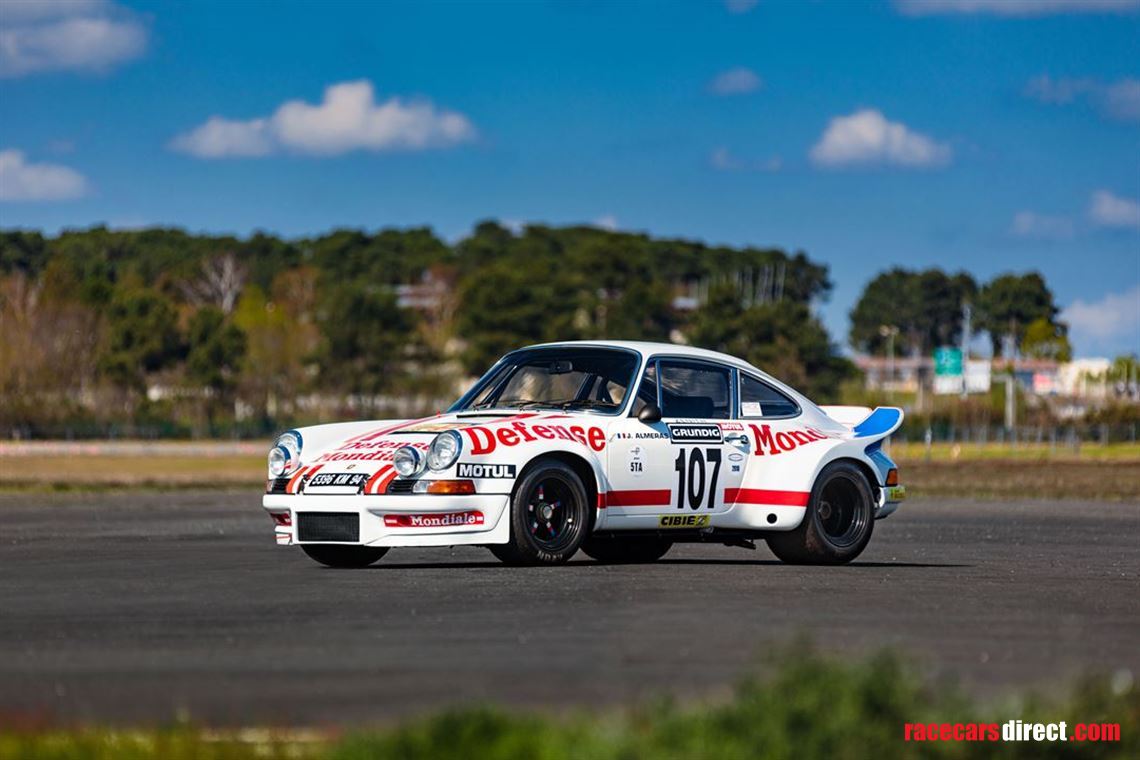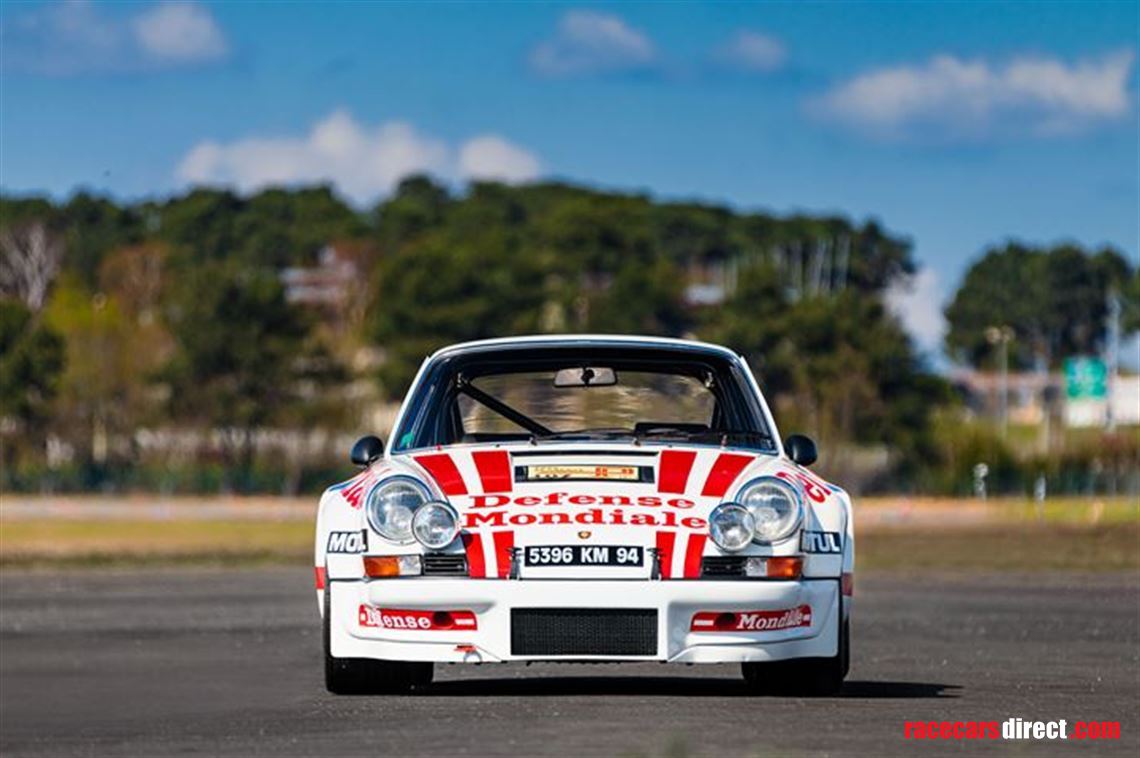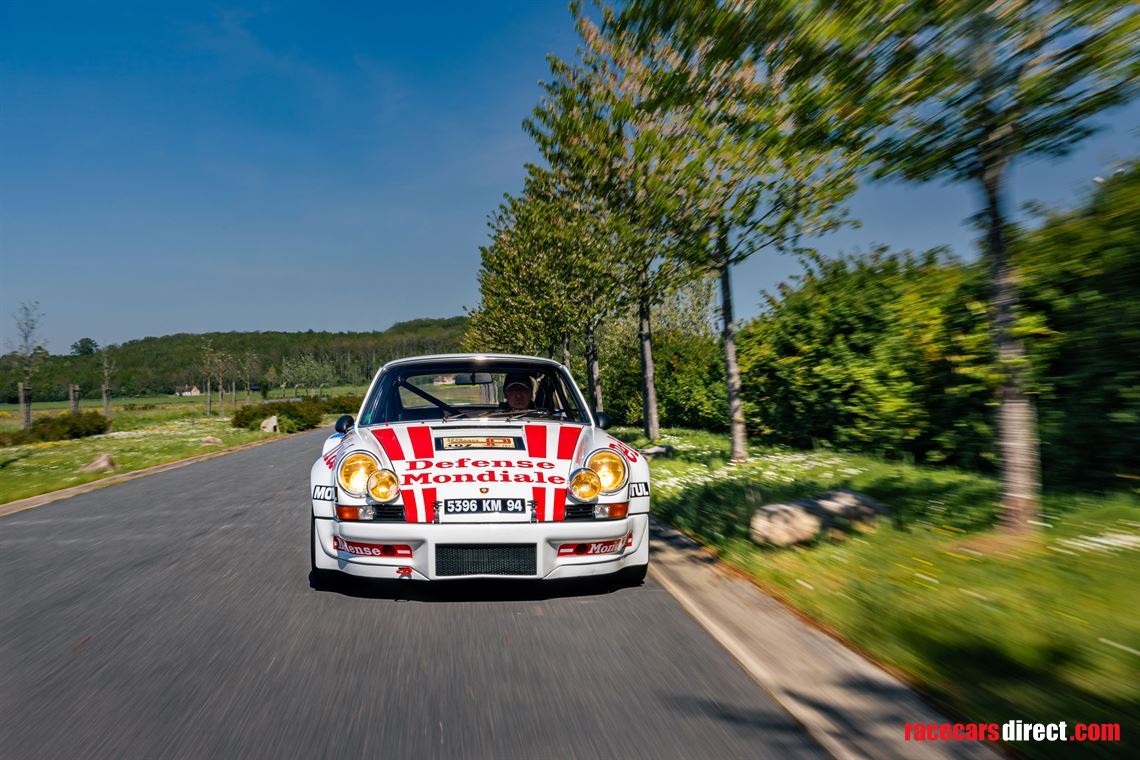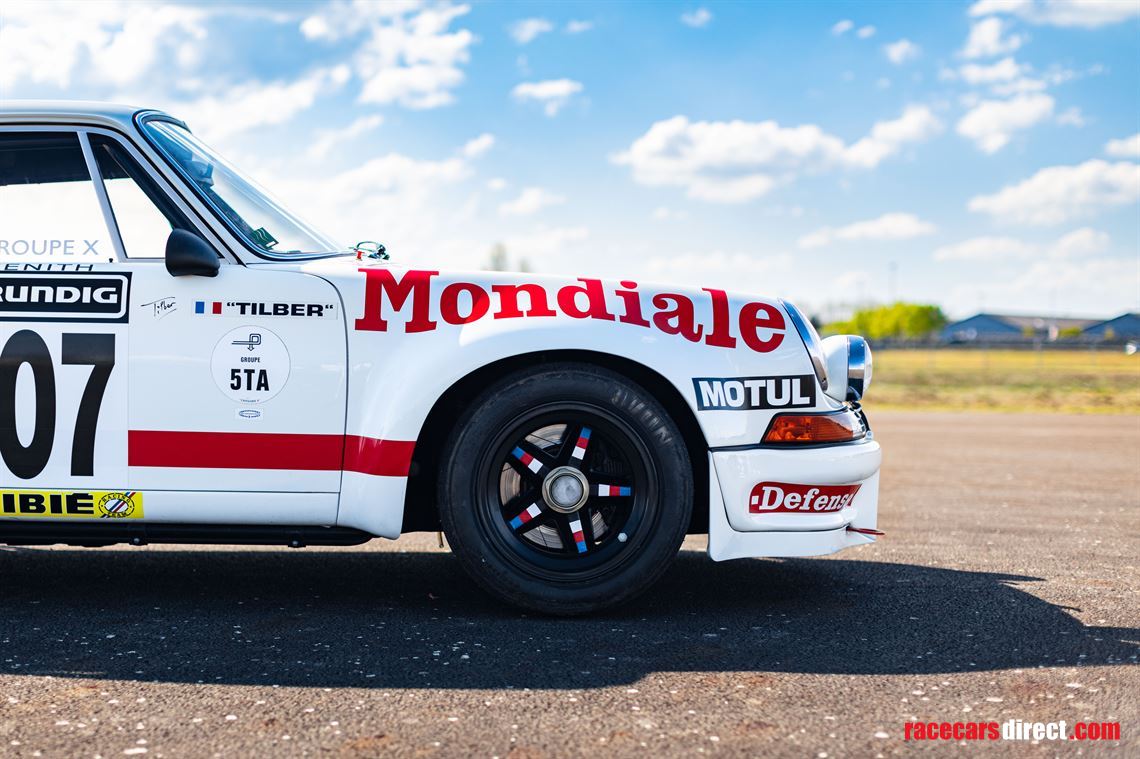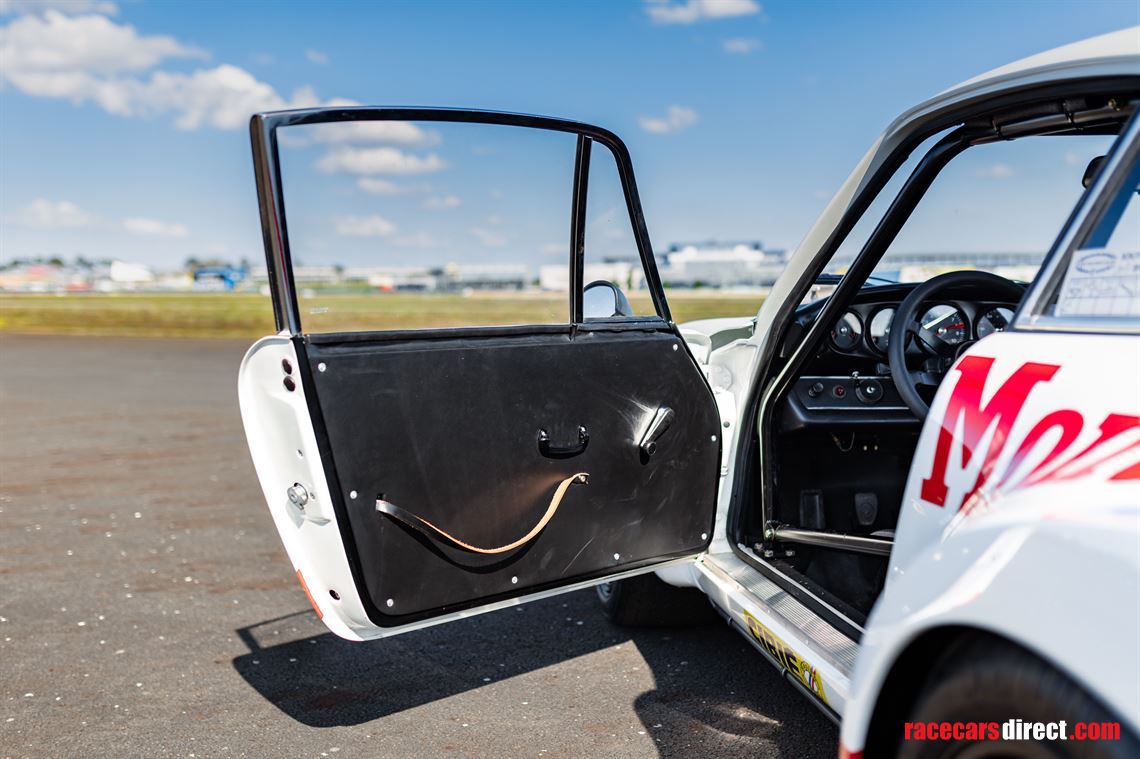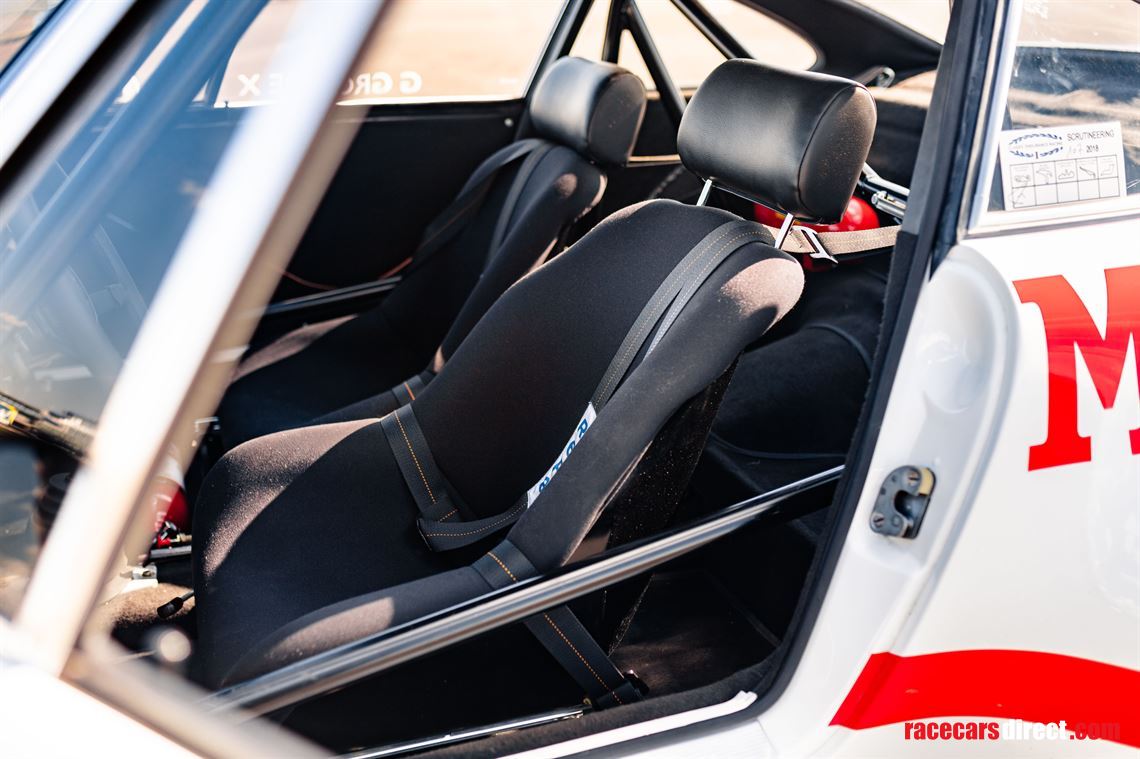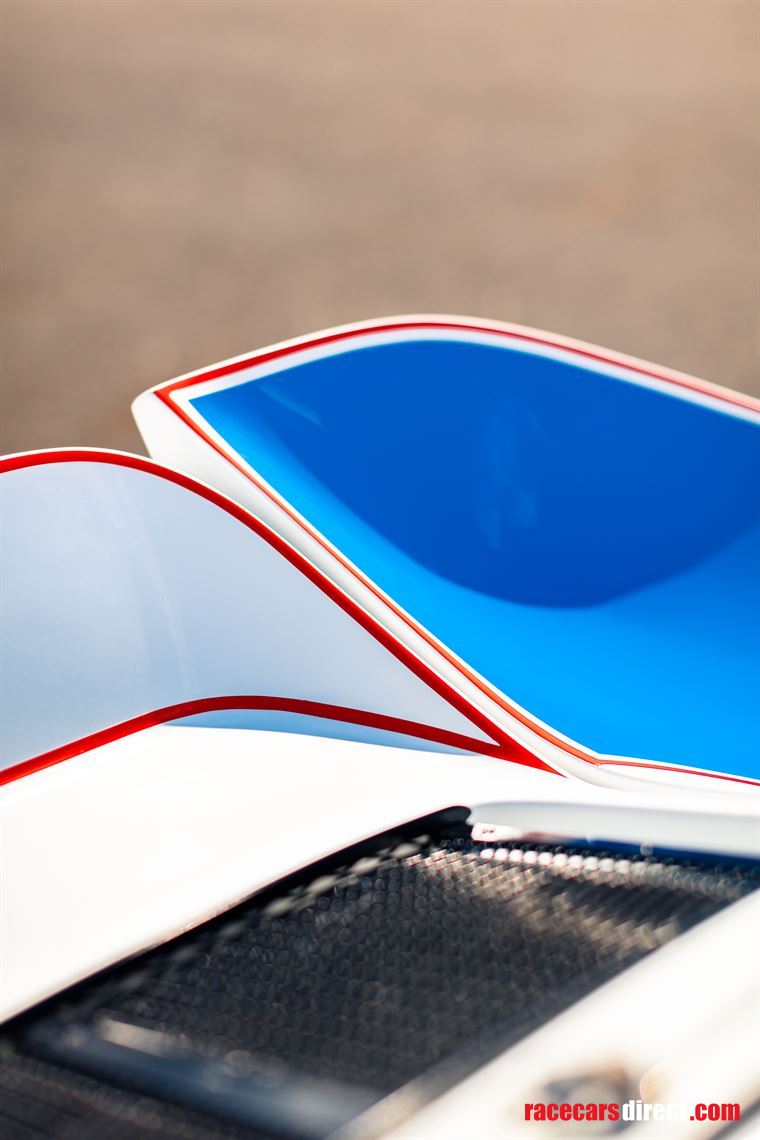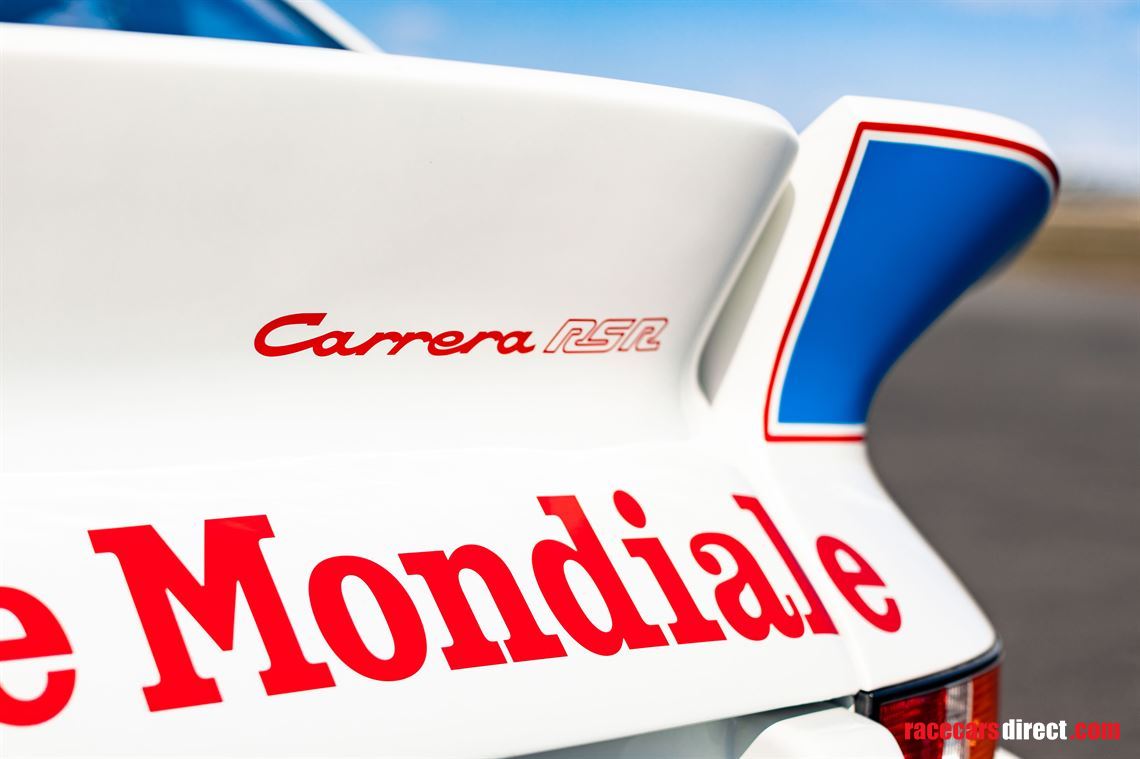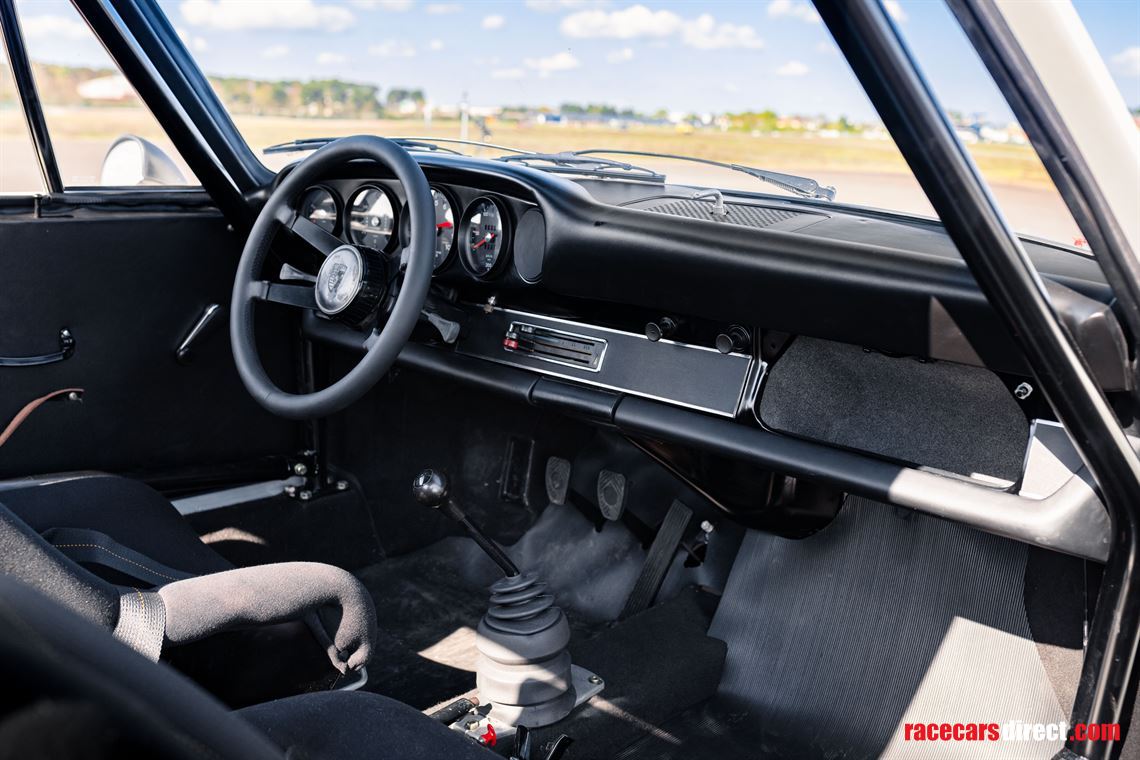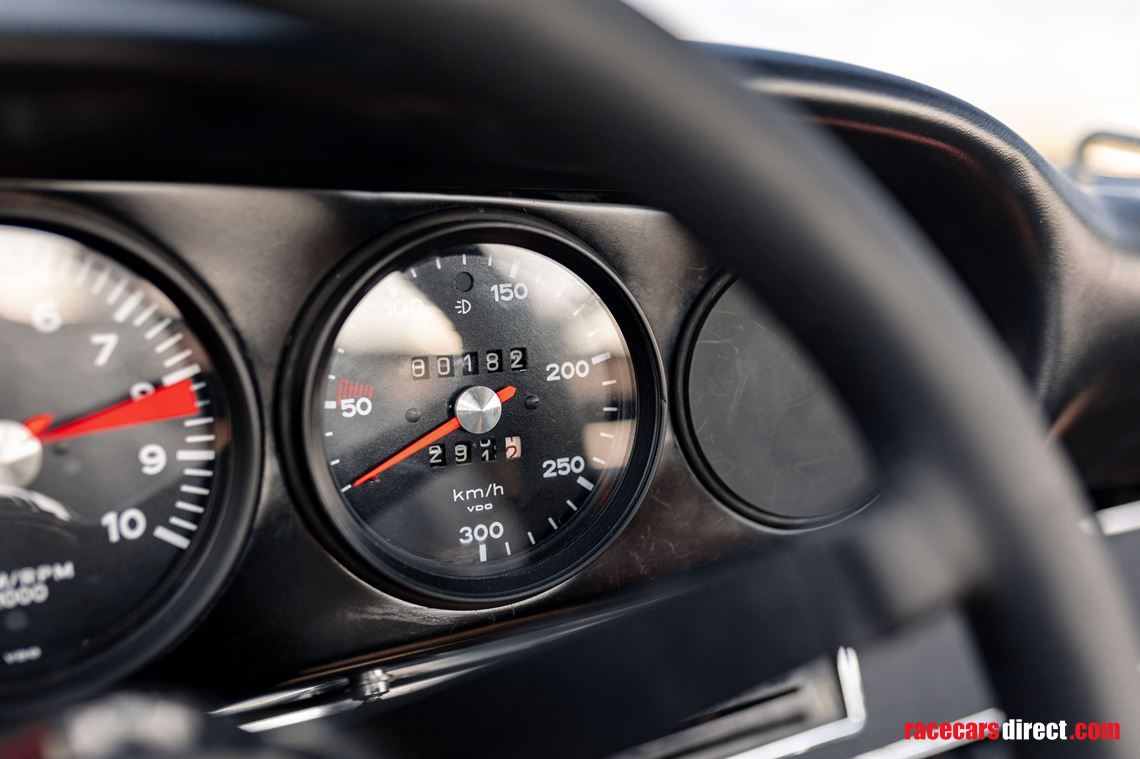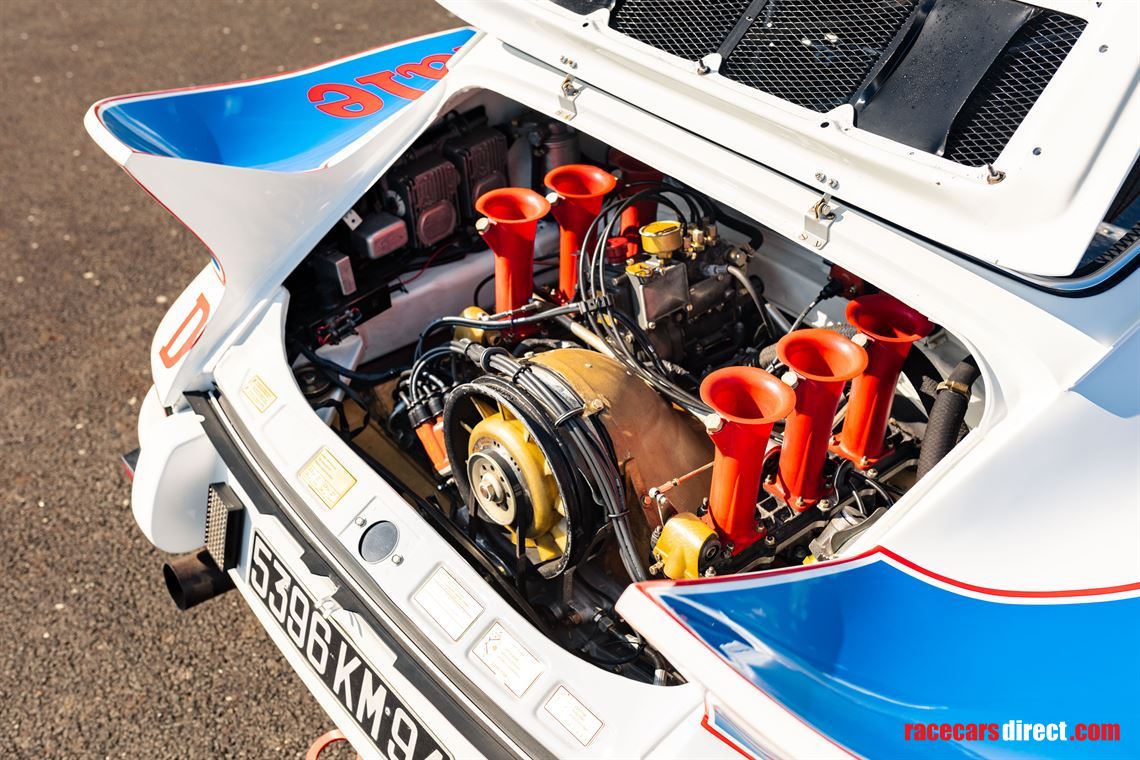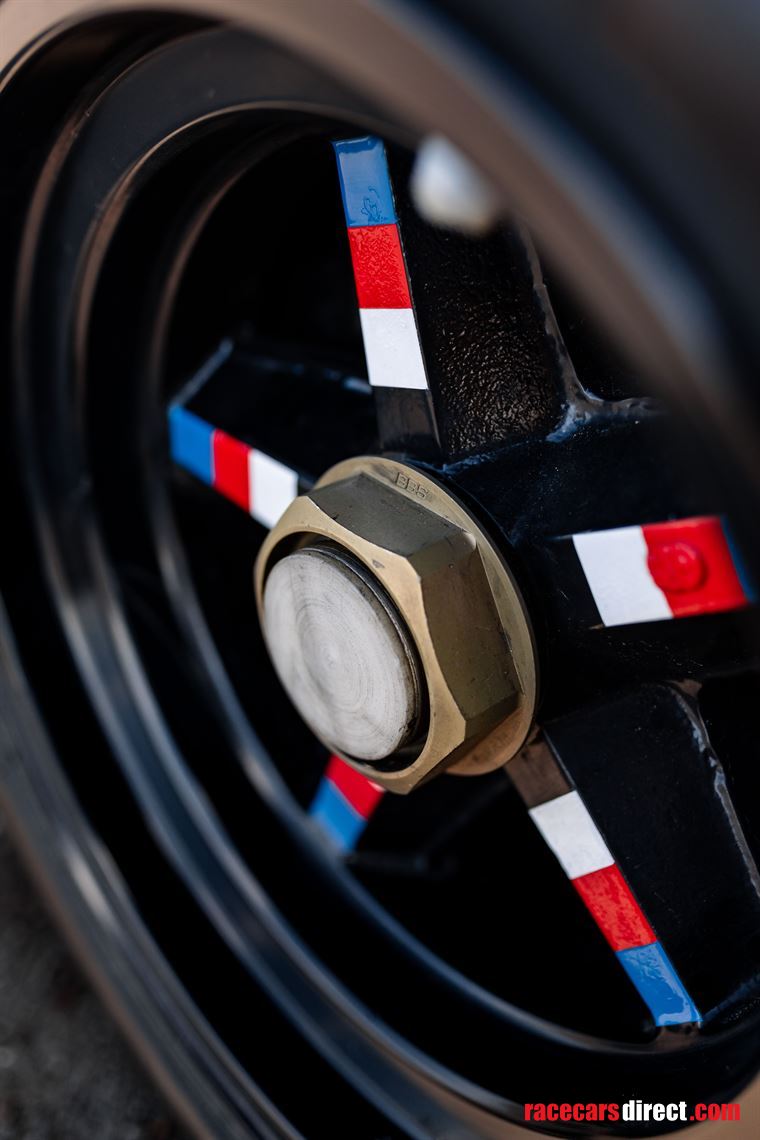Race Cars

£ POA
1973 Porsche 911 Carrera 2.8L RSR - SOLD
This is now SOLD. Search for similar items.
Description:
1973 Porsche 911 Carrera 2.8L RSR
Auction estimate: €1,000,000 - €2,000,000.
CHASSIS N° 9113601033 - PRODUCTION N° 1036160 - ENGINE N° AT911/74-6930155
COMPETITION CAR WITHOUT A CIRCULATION TITLE
An exceptional rarity, deafening performances
Car from the Défense Mondiale racing stable, driven by Jacques Alméras in 1973
Glorious track record including the best result achieved by a 2.8L RSR at the Tour Auto
Well-known and documented history for this authentic specimen
Comprehensive high-quality restoration completed less than 200 kilometers ago
Iconic "Mary Stuart" configuration, identical to that of factory cars
Extensive historical file with numerous periode photos
ACHIEVEMENTS
1973
French Mountain Championship, Group 4, with J. Alméras
2nd place overall in the Tour de France Automobile, Group 5, with J. Alméras and S. Mas
1975
French Rally Championship, Group 3, with JF. Mas
2nd place overall in the Tour de France Automobile, 1st in class, Group 3, with JF. Mas and "Tilber"
And over 60 other participations in motor racing events between 1976 and 1982.
The Porsche 911 boasts one of the most memorable careers in the history of the automobile. Among the multitude of generations, versions, and limited series, none has garnered as much respect and desire as its competition variant.
After tremendous efforts to establish dominance on the circuits during the 1960s by Ferdinand Piëch, the grandson of Porsche’s founder, victory finally arrived with the legendary 917. Dubbed the «competition car of the century,» it utterly dominated the World Sports Car Championship for several seasons, until a regulation change by the FIA in 1972 bringing the maximum allowed displacement of prototypes down to 3.0L.
This evolution marks the end of the golden age of endurance racing, and with prototypes losing their influence, Porsche, despite continuing to compete in the 3.0L Sport category with eligible cars, is forced to find a successor to the 917. The brand decided to focus its interest on the FIA Grand Touring category, present in numerous competitions of the time. The Group 4 regulations for special grand touring cars within this category stipulated a minimum production requirement of 500 units within a year, While permitting a few modifications in relation to the base model. Thus, the 911 emerges as the ideal car for Piëch’s team.
Already famous for its impact on the pop culture of the 1960s, the 911 brought to Porsche unprecedented commercial success. However, this was not immediately the case on the circuits where it was still unknown at the time. Nevertheless, the car being already well known to the manufacturer, helped to limit costs in terms of research and development compared to creating new prototypes. The racing department then focused on the car and addressed its slight high-speed handling issue due to its architecture.
The aerodynamics were redesigned, giving birth to a wing attached to the trunk - now nicknamed the «ducktail.» The front received a new spoiler better equipped to accommodate a new ventilation system and to press the car to the ground at high speeds. The body is lightened by using thinner sheet metal in certain areas and reducing the number of tin joints. The glass windows were replaced with special, much lighter, glass and the interior was stripped of any unnecessary elements. The flat-six engine was enlarged to 2.7L of displacement to develop a total power output of 210 horsepower. This enhanced sporty 911 was given the nickname of the most powerful version of the 356, winner of the Panamericana in Mexico: the Carrera; placed before the acronym RS for «Rennsport» (racing in German). The 911 Carrera RS 2.7L was presented at the Paris Motor Show on October 5th, 1972.
Designed and marketed as a «customer competition» car it was, at the time, deemed the fastest German car. The enforced production minimum of 500 units was greatly surpassed with a total of 1,580 cars manufactured. This not only enabled homologation in Group 4 but also in Group 3, for which the minimum production requirement was set at 1,000 units.
Encouraged, Porsche decided to take the development even further by devising a model that would allow customers to dominate the circuits by entering extremely competitive cars, securing countless victories and thus establishing the manufacturer as a key player on the motorsports circuit.
The engine of the Carrera RS 2.7L was once again enlarged, this time to 2.8L, equipped with larger valves and lightweight mechanical components, high-compression pistons, dual ignition, and a Bosch mechanical injection. This engine type was designated as the 911/72. The five-speed gearbox was specifically designed for this extreme sports car, utilizing production parts but adapted and equipped with its own cooling system. The suspension system was reinforced and stiffened. The braking system was primarily derived from the 917. The haunches of the car were widened to accommodate 230mm tires at the front and 260mm tires at the rear, enhancing its particularly aggressive and compact appearance, while lightweight Fuchs competition wheels completed the ensemble.
These numerous improvements allowed the power to go up to over 300 horsepower, while keeping the weight of the car under 900 kilograms. No other 911 was more powerful and performance-oriented than this 911 Carrera 2.8L «RSR,» which stands for Rennsport Rennwagen (racing sports car). It should be noted that this mechanical tornado came with a price tag, at the time, of 25,000 Deutschemarks, equivalent to the combined price of a 911 Carrera RS 2.7L and a standard 911. All this work pays off as the 2.8L RSR achieves immediate success within its first year of competition, clocking up numerous national and international wins: the Trans-Am series and IMSA GT in the USA, the GT European Championship, the European Mountain Championship, and more.
Its greatest achievements in the 1973 World Endurance Championship were accomplished at the 24 Hours of Daytona and the Targa Florio, where it emerged victorious against Ferrari, Chevrolet, Lancia, and other Lola cars. Furthermore, it boasts additional triumphs in the Grand Touring category, where the RSR dominated the Championship without giving its competitors even the slightest chance. It secured first place in its class at the 6 Hours of Vallelunga and Watkins Glen, as well as the 1 000 km races in Dijon, Monza, and Spa... overall, the RSR emerged victorious in 7 out of the 9 major GT competitions of that season. Only 49 units of the 911 Carrera 2.8L RSR were assembled by the Porsche factory before the new 3.0L version came into existence.
The Porsche 911 Carrera 2.8L RSR offered for sale as part of the exceptional auction collection is precisely one of these specimens and, arguably, one of the most representative of this model of competition 911. The car, chassis number 9113601033, was imported new to France. Ordered through the French importer Sonauto in April 1973 for the «Défense Mondiale» team, it came painted in Grand Prix White with red stripes. It is believed to be the second out of the four 2.8L RSRs imported to France and the 35th produced overall. It was ordered with a special gearbox (for mountain use) to be made available to driver Jacques Alméras, whose specialty was hill climb racing. He immediately clinched the title of French Hill Climb Champion in the Group 4 category with this car.
Shortly thereafter, he participated, along with his teammate Serge Mas, under the number 107, in the 1973 Tour de France, competing in the Group 5 category, where they finished 2nd overall. It was for this race, following the homologation of the new crankcase that enabled the assembly of the 3.0L RSR engines, and in order to take advantage of the displacement limit in this class (Group 5 set at 3.0L), the engine block was reportedly sent back to the factory for overboring, and it was registered as a 911/74 (AT) type corresponding to a 3.0L RSR version with 335 horsepower, retaining its original number.
It was also during this time, given that the Group 5 category was more permissive than the previous Group 4 category in which this 2.8L RSR had been competing, that it underwent aesthetic modifications inspired by the factory RSR from the 1973 24 Hours of Le Mans. It was slightly widened and the spoiler was modified, but most notably, it was equipped with a rear wing extending over the rear fenders, in addition to the ducktail spoiler on the rear deck, forming an encompassing rear wing, affectionately nicknamed «Mary Stuart» due to its resemblance to the collar seen in portraits of the Queen of Scots.
Combined with its highly distinctive livery, this aerodynamic appendage, akin to a «factory» upgrade, adds to the cars unique identity making it easily recognizable to all enthusiasts, especially given its impressive track record.
In 1974, the 911 2.8L RSR #1033 then passed into the hands of Jean Benaba, a driver from the south of France who competed in hill climb races. In order to adapt the car for this purpose, he transformed it back (at least partially) into a Group 4 car, fitting the rear section with a «whale tail» spoiler borrowed from the 3.0L RSR. Later, in 1975, Jean-François Mas took over this 911 2.8L RSR and entered it in the French Rally Championship, this time in the Group 3 category. Not only did he win the championship in that category that season, but he also achieved a remarkable feat with his co-driver Tilbert (aka Christian Gilbert) under number 161, securing a 2nd place overall in the Tour de France and winning their Group 3 class. It’s noteworthy that this 2nd place in the 1975 Tour de France Automobile was accomplished by #1033, which was no longer a powerful Group 5 car as it was in 1973, but a Group 3 with a basic RS engine.
Up until then, this 911 2.8L RSR had continued to compete under the banner of Défense Mondiale and was prepared by Alméras Frères. However, in 1976, it was sold to Armand Lemay, an architect and gentleman driver from the north of France, marking a change in its trajectory. Lemay entered the car in numerous regional rallies and modified it according to the evolving regulations of the FIA, ensuring it remained eligible to compete in various categories, until it became outdated. After that, he kept it as a cherished trophy for several years, preserving its former racing glory. In 1987, he sold it to a Parisien enthusiast, who, devoted to the car with its impressive bodywork and amazing track record, preserved it in its current condition for over 25 years. It was then acquired by a well-known collector from Monaco about a decade ago, who set out to restore its former splendor.As the owner of prestigious Porsches such as the 917 and several 911 RSR models, the new owner commissioned a complete restoration of the 911 2.8L RSR #1033 to the highest standards of excellence, returning it to its most iconic configuration: the «Mary Stuart» Group 5 livery of the Défense Mondiale racing team from the 1973 Tour Auto.
It is in this enhanced yet historically significant form, that it is presented today. It is in excellent condition, having covered less than 200 Km since the restoration was completed. In 2017, after the restoration works were finished, it obtained a FIVA identity card and a request for Historic Technical Passport (PTH) was made, allowing the car to compete in historic racing events. It made its debut at the Espiritu de Montjuic in 2018 as part of the Peter Auto Series, with none other than Jacques Almeras behind the wheel - nearly 45 years after his participation in the 1973 Tour Auto with the car in its original configuration, including its corresponding race number. Some time later, the current owner acquired it along with other competition cars from the famous Monaco-based collector who led the restoration, but has barely used it.
Given its well-documented and referenced history, this 911 Carrera 2.8L RSR, now in exceptional condition due to the high-level restoration performed and notably retaining its original engine (serial number 6930155) bored out to a «prototype» 3.0L displacement, as well as its special gearbox (unreadable serial number 7931040), presents a high degree of authenticity. Sold fully documented with a file that includes a copy of the authentication certificate issued by Porsche in 2014, its FIVA card, and the 2017 PTH application, along with various archival documents. It also includes a significant expertise report and historical documentation by Jean-Pierre Cornu from 2019. Numerous photographs of the car in action, tracing its extensive racing career and forming an evocative historical dossier, complete the collection. Therefore, this 911 Carrera 2.8L RSR #1033 is a remarkable car from every perspective: its configuration, performance, and achievements. There is no doubt that the RSR version embodies a significant chapter in the history of competition. More exclusive than a Carrera RS, it is an authentic race car that has graced numerous circuits. Equipped with the most advanced mechanical refinements of its time, it annihilated the competition and became the world champion in the Grand Touring category in 1973. Already impeccably restored, this car will bring joy to its future owner, who will have the pleasure of entering it in the most prestigious historic competitions. Its exceptional rarity, coupled with its thunderous performance, will undoubtedly set it apart from its competitors.

